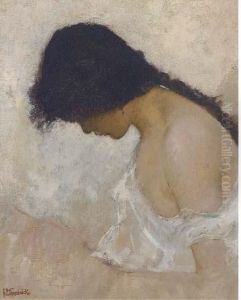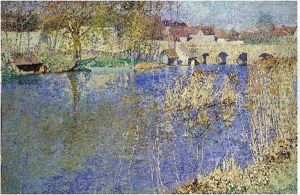Francis Brook Chadwick Paintings
Francis Brooks Chadwick was an American painter born on June 23, 1850, in Boston, Massachusetts. His early life in the United States laid the foundation for his artistic journey, but it was his time in Europe that defined his career. Chadwick's education in art began in earnest when he moved to Paris to study at the prestigious Académie Julian. There, he was mentored by notable artists such as William-Adolphe Bouguereau and Tony Robert-Fleury, who were instrumental in shaping his technique and artistic sensibility. The academic training he received, characterized by rigorous drawing lessons and a deep engagement with the classical tradition, was complemented by his exposure to the burgeoning impressionist movement, which would leave a lasting imprint on his work.
Chadwick became an active participant in the vibrant expatriate artist community in Paris and later in the artist colony of Grez-sur-Loing, where he was influenced by the natural beauty of the French countryside. This period was marked by his experimentation with plein air painting, a method that allowed him to capture the transient effects of light and atmosphere, a hallmark of the Impressionist style. Despite his association with Impressionism, Chadwick's work often retained a certain academic rigor in its composition and technique, reflecting his formal training.
Throughout his career, Chadwick exhibited his work widely, including at the Paris Salon, where he gained recognition and accolades for his contributions to contemporary art. His paintings, characterized by their vibrant color palette and delicate treatment of light, often depicted landscapes, genre scenes, and portraits, capturing the essence of his subjects with sensitivity and depth.
In the early 20th century, Chadwick returned to the United States, where he continued to paint, exhibit, and contribute to the American art scene. He became a bridge between the American and European art worlds, sharing the influences and innovations he had absorbed in France with his contemporaries in the United States. Francis Brooks Chadwick's legacy is that of a transatlantic artist who successfully melded the academic traditions of his training with the modernist impulses of his time, leaving behind a body of work that continues to be appreciated for its beauty and historical significance. He passed away on July 14, 1943, leaving a lasting impact on the field of American art.

